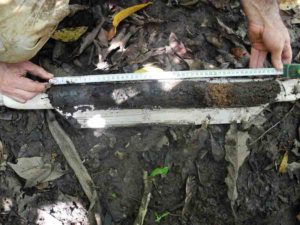
“Mauritia flexuosa” is the most widespread plant in the Orinoco Delta, in north-western Venezuela. This has not always been the case in the past. This palm, locally known as “moriche”, started its domination over the vegetal community of the area 3000 years ago, according to a new research that has reconstructed for the first time the ecological dynamics and evolution of the Orinoco’s Delta for the last 6200 years. The authors of the study, which has been published in Quaternary Science Reviews, have been able to identify 3 different periods characterized by different types of vegetation.
“With this research we have seen the importance of both local and superregional natural drivers in the vegetation dynamics”, says Encarni Montoya, researcher at Institute of Earth Sciences Jaume Almera of the Spanish National Research Council (ICTJA-CSIC) and lead author of the study.
Researchers extracted a 141 cm-long sediment core from a swamp near “caño Tigre”. The sediment samples were analysed by means of paleomagnetic techniques, X Ray diffraction, and stable isotope analysis.
Moreover, scientists analysed pollen samples from the recovered sediment core to know the vegetation type that existed in the area throughout the studied period. A radiocarbon analysis was carried out to date exactly the different layers of the sediments. Charcoal particles were also analysed as a proxy to obtain information about the fires occurred in the region, from which obtain clues about human settlement periods.
researchers notes that, although forested during the last 6200 years, the composition of the forest of the region have greatly varied through the time. Thanks to the fossil pollen samples found in the sediments, researchers could identify three well-distinguished periods depending on the different vegetal species that populated the delta.
According to the study, the first vegetal community, the oldest odf the register, was a mixed rainforest with coastal elements. This community was replaced 5400 years ago by a more inland-mixed-swamp forest community, a shift probably related with the progress of the coastline as a consequence of the sea level stabilization after the deglaciation.
Finally, 3000 years ago, the current vegetal community was established: a swamp dominated by “Mauritia flexuosa” palm”, during a wide unstable climatic period under the influence of the El Niño–Southern Oscillation (ENSO).
The indigenous Warao culture calls “Mauritia flexuosa” “The tree of life”, highlighting the importance of this palm for this human community that live dispersed in an intricate labyrinth of river channels and creeks of the Orinoco Delta.
“Processes like the sea level rise after the last glaciation or the frequency and intensity of climatic phenomena like the ENSO are crucial in determining the type of vegetation that establishes or persists in a new community”, notes Montoya, who is currently professor at University of Liverpool.
According to Encarni Montoya, this research shows “how fast the vegetal community of the delta has responded to the environmental changes throughout the last 6200 years, a process of special interest to understand the possibly future scenery marked by global change”.
“Coastal systems, and specially the deltas are especially vulnerable to the climate changes due to its proximity to the sea”, explains Encarni Montoya. “Given the variety of factors that may disrupt in this areas, the studies about the behaviour and dynamics of the ecosystem are fundamental”, adds the researcher who hopes that this work “awakes the interest of the scientific community and the society for this so magnificent area which is still unknown and which is currently facing some human induced threats, like oil prospection and extraction activities”.
The Orinoco is one of the largest rivers of South America and it discharges into the Atlantic Ocean in the North East of Venezuela, where it forms a big delta shaped by hundreds of little rivers and channels (called “caños”).
Reference:
Montoya, E., Pedra-Méndez, J., García-Falcó, E., Gómez-Paccard, M., Giralt, S., Vegas-Vilarrúbia, T., W. Stauffer, F., Rull, V. (2019) Long-term vegetation dynamics of a tropical megadelta: Mid-Holocene palaeoecology of the Orinoco Delta (NE Venezuela). Quaternary Science Reviews. Volume 221, 105874, DOI: 10.1016/j.quascirev.2019.105874.
Note: The above post is reprinted from materials provided by Institute of Earth Sciences Jaume Almera of the Spanish National Research Council (ICTJA-CSIC). The original article was written by Encarni Montoya.










